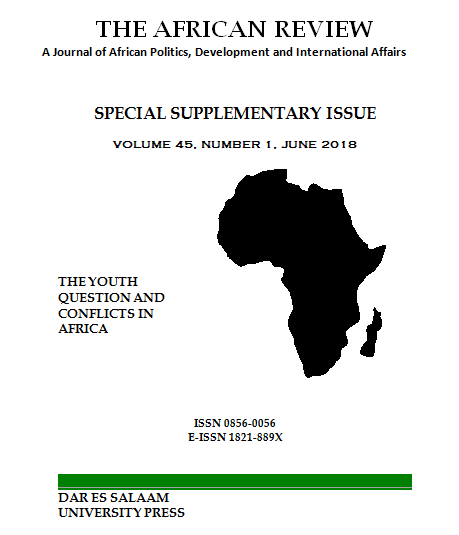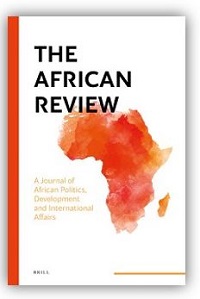Understanding community resilience amidst rising violent conflicts in Tanzania
Abstract
Tanzania is experiencing an upsurge of violent conflicts, some of which have tended to have extremist bearings. Based on a qualitative study in Mwanza and Pwani regions, this paper posits that the relative presence, absence or prolongation of violent incidents in some areas, is best explained by community resilience mechanisms in place to prevent and counter violence. Subsequently, communities that have invested in early warning and response mechanisms are relatively positioned to prevent and counter violent conflicts. In the absence of functional community early warning structures, as is the case in Pwani, it makes it so difficult for the state security organs to interact with communities and gather intelligence security information allowing responding to insecurities. The paper calls for a policy shift to invest in community early warning and response systems as vital forms of resilience to prevent and to counter rising forms of violent conflicts in Tanzania.
Keywords: Tanzania, Resilience, Violent Conflicts, Security, Community
William J. Walwa, Lecturer, University of Dar es Salaam, Email: walwajn@gmail.com
References
Abdalla, A. 2016. Say Peace: Islamic Perspectives on Conflict Resolution: Training Manual for Muslim Communities. Washington D.C: Salam Institute for Peace and Justice.
Aisenberg, E and Herrenkohl, T. 2008. "Community Violence in the Context: Risk and Resilience in Children and Families," Journal of Interpersonal Violence, 23: 296315.
Ansari, S. and Bruell, C. 2009. "Community Policing and Social Capital: An Interactional Model" Paper presented at the annual meeting of the ASC Annual Meeting, Philadelphia Marriott Downtown, Philadelphia, PA, November 04.
Benjaminsen, T., Maganga, F., and Abdallah, J. 2009. "The Kilosa Killings: Political Ecology of a Farmer €“Herder Conflict in Tanzania, "Development and Change, 40(3): 423 €“445.
Berkes, F. and Ross, H. 2013. "Community Resilience: Toward an Integrated Approach," Society and Natural Resources, 26:5-20.
Coning, C. 2016. "From peace building to sustainable peace: Implications of complexity for resilience and sustainability, "Resilience, 4 (3): 166-181.
Fukuyama, F. 1992. The End of History and the Last Man. New York: The Free Press.
Heidelberg Institute for International Conflict Research. 2012. Conflict Barometer, 2012.
Heilman, B. and Jingu, J. 2015. "Natural Resource Trap: insights from Mtwara Gasrelated Violence", in Mukandala, R. S. eds. The Political Economy of Tanzania in Tanzania: Contestation over Identity, the Constitution and Resources, Dar es Salaam: Dar es Salaam University Press.
Heilman, B. and Kaiser. P. J. 2002. "Religion, identity and politics in Tanzania, "Third World Quarterly, 23 (4): 691-707.
Institute for Economics and Peace. 2017. Measuring Peace in a Complex World: Global Peace Index. Syney, Australia.
Interpeace. 2016. "Using Resilience to Build Peace", http://www.interpeace.org/wpcontent/uploads/2016/06/Practice_Brief-Resilience_and_Peacebuilding-A4v3.pdf, accessed on 17.08.2017.
Lucas, L. (15.4.2015a). Watu 10 wakamatwa msikitini wakiwa na milipuko, sare za jeshi, bendera ya Al Shabaab. Mwananchi.
Lucas, L. (3.5.2015b). Ugaidi watikisa tena Morogoro. Mwananchi.
Majan, F. and Yacub, B. (16.2.2015). Hali si Shwari Nchini. Mwananchi.
Mangala, P. (30.12.2013). Wakulima, Wafugaji Wauana Kinyama. Mtanzania.
Marshall, M. and Cole, B. 2011.Global Report 2011: Conflict, Governance, and State Fragility, Vienna Virginia: Center for Systematic Peace.
Menkhaus, K. 2013. "Making Sense of Resilience in Peacebuilding contexts: Approaches, Applications and Implications", Peacebuilding platform, 6: 1-10.
Mpangala, G. 1999. Peace, Conflicts and Democratization Process in the Great Lakes Region: The Experience of Tanzania. Dar es Salaam: Institute of Development Studies.
Mukandala, R. S. eds. 2006. Justice Rights and Worship: Religion and Politics in Tanzania, Dar es Salaam: REDET and E&D Limited.
Muyomba, F. (12.2.2013). Haki ya kuchinja Waislamu, Wakristo wapigana mapanga. Majira.
Mwananchi (15.4.2017) Jinsi mauaji ya kutisha ya polisi nane yalivyofanyika.
Mwananchi (24.5.2017). Kwa nini kazi ya kuwasaka wauaji inakuwa ngumu?
Mwilo. S. and Chilongola, P. (13.7.2015). Watu Wenye Silaha Wavamia Kituo cha Polisi Dar, Waua, Waiba Silaha. Mwananchi.
Nicholl, C. G. 2000. Community Policing, Community Justice and Restorative Justice: Exploring the Links for the Delivery of a Balanced Approach to Public Safety.Washington, DC: United States Department of Justice, Office of Community Oriented Policing Services.
Njoji, A. (13.1.2014). Mgogoro wa Ardhi Kiteto Waua Watu. Nipashe. Njoji, A. (30.12.2013). Mapigano ya Wakulima, Wafugaji Yaua Wanane. Nipashe.
Njoji, A., Massano, J. and Kitomari, S. (16.01.2014). Kiteto Moto. Nipashe.
Pandey, V. 2014. "Community Policing for Conflict Resolution and community Resilience,"International Journal of Social Work and Human Services Practice, 2 (6): 229-233.
Raia Mwema. (28.2.2013). Mauaji ya viongozi wa dini: Tuna dhamira ya kuyakomesha?
Ramalingam, B. 2013. Aid on edge of chaos. Oxford: Oxford University Press.
Samoff, J. 1973."Cell Leaders in Tanzania: A review of Recent Research", TAAMULI: A Political Science Forum, 4 (1): 63-75.
Walsh, F. 2007. "Traumatic Loss and Major Disasters: Strengthening Family and Community Resilience ' , Family Process, 46 (2): 207-227.
Walwa, W. J. 2016. "Large-scale mining and the right to a clean, health and safe environment in Tanzania," the African Review, 43 (2): 97-123.
Walwa, W. J. 2017. "Governing Security at the Grassroots Level: Effectiveness of Community-Led Security Mechanisms in Tanzania", the African Review, 44 (1): 103-142.
Downloads
Published
Issue
Section
License
Copyright © by Department of Political Science and Public Administration, University of Dar es Salaam
All rights reserved. No part of this publication may be reproduced or transmitted in any form or by any means, electronic or mechanical, including photocopying, recording, or any information storage or retrieval system, without permission in writing from the publisher, except for short extracts in fair dealing, for research or private study, critical scholarly review or discourse with an acknowledgement.
The African Review: A Journal of African Politics, Development and International Affairs [ISSN 0856-0056 (Print) & ISSN 1821-889X (Online)] is published bi-annually, June and December by the Department of Political Science and Public Administration, University of Dar es Salaam, P.O. Box 35042 €“ Dar es Salaam €“ Tanzania



